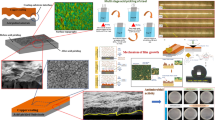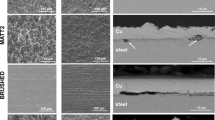Abstract
The antimicrobial effect of copper (Cu) as well as its potentiality to reduce healthcare-associated infections is well recognized. In this study, a twin wire arc spray gun has been used to produce antibacterial copper coatings on stainless-steel (316L) surfaces. The thickness of coating was 120 ± 30 μm in average. In parallel, series of coating formation simulations were made using Comsol Multiphysics. The coating morphology was examined by scanning electron microscope (SEM) and its structure determined by x-ray diffraction (XRD). Surface roughness measurements were carried out on as-sprayed and polished surfaces by using a 3-D Profilometer. The coating antibacterial efficacy has been investigated considering standard and clinically isolated cultures such as standard ATCC 25922 Escherichia coli (E. coli), standard ATCC 29213 Staphylococcus Aureus (Staph. Aureus), clinically isolated Pseudomonas aeruginosa, Vancomycin-resistant Enterococcus (VRE) and Methicillin-resistant Staphylococcus aureus (MRSA). The predictions of simulations matched with the monitored data with an error below 10%. The coatings exhibited excellent antibacterial properties for all the pathogen types used.







Similar content being viewed by others
References
C.D. Salgado, K.A. Sepkowitz, J.F. John, J.R. Cantey, H.H. Attaway, K.D. Freeman, P.A. Sharpe, H.T. Michels, and M.G. Schmidt, Copper Surfaces Reduce the Rate of Healthcare-Acquired Infections in the Intensive Care Unit, 2013, 34(5), p 479-486
G. Grass, C. Rensing, and M. Soloz, Metallic Copper as an Antimicrobial Surface, Appl. Environ. Microbiol., 2011, 77(5), p 1541-1547
R. Sharan, S. Chhibber, and R.H. Reed, A Murine Model to Study the Antibacterial Effect of Copper on Infectivity of Salmonella Enterica Serovar Typhimurium, Int. J. Environ. Res. Public Health, 2011, 8(1), p 21-36
J. O’Gorman and H. Humphreys, Application of Copper to Prevent and Control Infection. Where Are We Now?, J. Hosp. Infect., 2012, 81(4), p 217-223
T. Stoltenhoff, C. Borchers, F. Gärtner, and H. Kreye, Microstructures and Key Properties of Cold-Sprayed and Thermally Sprayed Copper Coatings, Surf. Coat. Technol., 2006, 200(16-17), p 4947-4960
S. Salavati, T.W. Coyle, and J. Mostaghimi, Twin Wire Arc Spray Process Modification for Production of Porous Metallic Coatings, Surf. Coat. Technol., 2016, 286(1), p 16-24
A. Abedini, A. Pourmousa, S. Chandra, and J. Mostaghimi, Effect of Substrate Temperature on the Properties of Coatings and Splats Deposited by Wire Arc Spraying, Surf. Coat. Technol., 2006, 201(6), p 3350-3358
V.K. Champagne and D.J. Helfritch, A Demonstration of the Antimicrobial Effectiveness of Various Copper Surfaces, J. Biol. Eng., 2013, 7(1), p 1-6
J.R. Wilson, The Structure of Liquid Metals and Alloys, J. Metall. Rev., 1965, 10(1), p 381-590
M.I. Boulos, P. Fauchais, and E. Pfender, Thermal Plasmas Fundamentals and Applications, Vol 1, Springer, Berlin, 1994, p 413-417
A.P. Abkenar, Wire Arc Spraying: Particle Production, Transport and Deposition, Ph.D. Thesis, University of Toronto, p 72-74. 2007. https://www.collectionscanada.gc.ca/obj/thesescanada/vol2/002/NR39723.PDF. Accessed 16 Sept 2018
R. Suryanarayanan, Plasma Spraying Theory and Applications, World Scientific Publishing, Singapore, 1993, p 121-135ISBN 981-02-1363-8
T. Blackburn, Test Method for the Continuous Reduction of Bacterial Contamination on Copper Alloy Surfaces. 800R09004, Enviromental Protection Agency (EPA), 2009. https://nepis.epa.gov/Exe/ZyPURL.cgi?Dockey=P1003RIK.txt. Accessed 17 Sept 2018
X. Wang, J. Heberlein, E. Pfender, and W. Gerberich, Effect of Nozzle Configuration, Gas Pressure, and Gas Type on Coating Properties in Wire Arc Spray, J. Therm. Spray Technol., 1999, 8(4), p 565-575
M.P. Planche, H. Liao, and C. Coddet, Relationships Between in-Flight Particle Characteristics and Coating Microstructure with a Twin Wire Arc Spray Process and Different Working Conditions, Surf. Coat. Technol., 2004, 182(2), p 215-226
O. Sharifahmadian, H.R. Salimijazi, M.H. Fathi, and J. Mostaghimi, Relationship Between Surface Properties and Antibacterial Behavior of Wire Arc Spray Copper Coatings, Surf. Coat. Technol., 2013, 223(1), p 74-79
R. Lupoi and W. O’Neill, Deposition of Metallic Coatings on Polymer Surfaces Using Cold Spray, Surf. Coat. Technol., 2010, 205(7), p 2167-2173
S. Zimmermann, E. Vogli, M. Kauffeldt, M. Abdulgader, B. Krebs, B. Rüther, K. Landes, J. Schein, and W. Tillmann, Supervision and Measuring of Particle Parameters During the Wire-Arc Spraying Process with the Diagnostic Systems Accuraspray-g3 and LDA (Laser-Doppler-Anemometry), J. Therm. Spray Technol., 2010, 19(4), p 745-755
S. Oukach, H. Hamdi, M. El Ganaoui, and B. Pateyron, Numerical Study of the Spreading and Solidification of a Molten Particle Impacting Onto a Rigid Substrate Under Plasma Spraying Conditions, Therm. Sci., 2015, 19(1), p 277-284
M. Pasandideh-Fard, R. Bhola, S. Chandra, and J. Mostaghimi, Deposition of Tin Droplets on a Steel Plate: Simulations and Experiments, Int. J. Heat Mass Transf., 1998, 41(19), p 2929-2945
O. Sharifahmadian, H.R. Salimijazi, M.H. Fathi, J. Mostaghimi, and L. Pershin, Study of the Antibacterial Behavior of Wire Arc Sprayed Copper Coatings, J. Therm. Spray Technol., 2013, 22(2–3), p 371-379
G. Ren, D. Hu, E.W. Cheng, M.A. Vargas-Reus, P. Reip, and R.P. Allaker, Characterisation of Copper Oxide Nanoparticles for Antimicrobial Applications, Int. J. Antimicrob. Agents, 2009, 33(6), p 587-590
A. Simchi, E. Tamjid, F. Pishbin, and A.R. Boccaccini, Recent Progress in Inorganic and Composite Coatings with Bactericidal Capability for Orthopaedic Applications, Nanomedicine, 2011, 7(1), p 22-39
H. Gutierrez, T. Portman, V. Pershin, and M. Ringuette, Evaluation of Biocidal Efficacy of Copper Alloy Coatings in Comparison with Solid Metal Surfaces: Generation of Organic Copper Phosphate Nanoflowers, J. Appl. Microbiol., 2013, 114(3), p 680-687
S.L. Warnes, J.C. Highmore, and C.W. Keevil, Horizontal Transfer of Antibiotic Resistance Genes on Abiotic Touch Surfaces: Implications for Public Health, Am. Soc. Microbiol. mBio, 2012, 3(6), p 1-10
J. Hemin, Y. Zhiming, and L. Li, Antibacterial Properties and Corrosion Resistance of Cu and Ag/Cu Porous Materials, J. Biomed. Mater. Res. Part A, 2008, 87A(1), p 33-37
S.L. Warnes and C.W. Keevil, Mechanism of Copper Surface Toxicity in Vancomycin-Resistant Enterococci following Wet or Dry Surface Contact, Appl. Environ. Microbiol., 2011, 77(17), p 6049-6059
C.E. Santo, N. Taudte, D.H. Nies, and G. Grass, Contribution of Copper Ion Resistance to Survival of Escherichia coli on Metallic Copper Surfaces, Appl. Environ. Microbiol., 2008, 74(4), p 977-986
D.J. Weber and W.A. Rutala, Self-Disinfecting Surfaces: Review of Current Methodologies and Future Prospects, Am. J. Infect. Control, 2013, 41(5), p 31-35
E.R. Kenawy, S.D. Worley, and R. Broughton, The Chemistry And Applications of Antimicrobial Polymers: A State-of-The-Art Review, Biomacromolecules, 2007, 8(5), p 1359-1384
K. Lewis and A.M. Klibanov, Surpassing Nature: Rational Design of Sterile-Surface Materials, Trends Biotechnol., 2005, 23(7), p 343-348
Acknowledgment
Part of this study was funded by TUBITAK TEYDEB under the project number 7120870, which is greatly acknowledged. Authors also thank ITU BAP for their grant under the contract number of 38367. Authors extend their appreciation to Prof. Dr. Gultekin Goller, Huseyin Sezer and Husnu Ozturk for their support in the SEM studies of the coatings.
Author information
Authors and Affiliations
Corresponding author
Electronic supplementary material
Below is the link to the electronic supplementary material.
Rights and permissions
About this article
Cite this article
Kocaman, A., Keles, O. Antibacterial Efficacy of Wire Arc Sprayed Copper Coatings Against Various Pathogens. J Therm Spray Tech 28, 504–513 (2019). https://doi.org/10.1007/s11666-018-0824-x
Received:
Revised:
Published:
Issue Date:
DOI: https://doi.org/10.1007/s11666-018-0824-x




